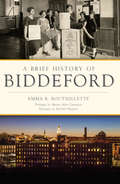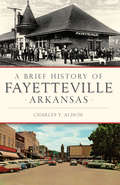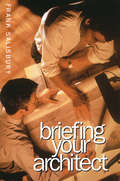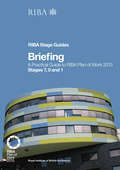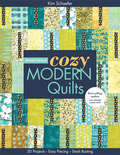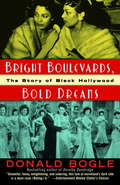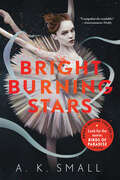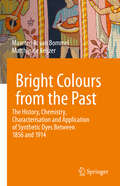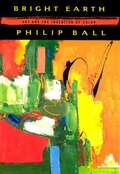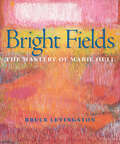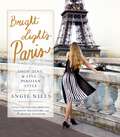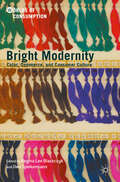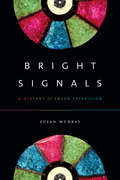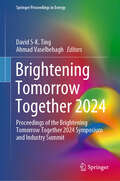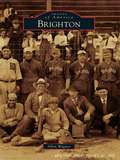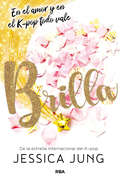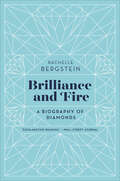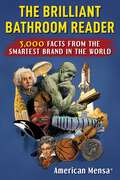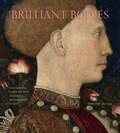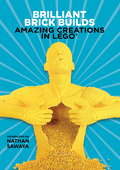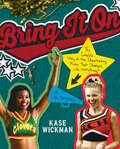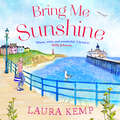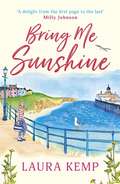- Table View
- List View
Brief History of Biddeford, A (Brief History)
by Emma R. Bouthillette Epilogue By Poupore Prologue By CasavantCaptain Richard Vines founded Winter Harbor in 1616. The small coastal village, now known as Biddeford, is the largest city in York County, with more than twenty-one thousand residents. During the nineteenth century, the city experienced a boom from the textile industry when textile magnate Samuel Batchelder established Pepperell Manufacturing Company, which rapidly became an international brand. The city suffered when textile manufacturing moved south in the mid-twentieth century, abandoning its expansive infrastructure along the Saco River. In 2004, Mayor Wallace Nutting organized local residents in a revitalization effort for the downtown area, and developers renovated historic mill buildings into residential and commercial space. Join author and lifelong Biddeford resident Emma Bouthillette as she revisits the city’s early history and explores its recent rebirth.
Brief History of Fayetteville Arkansas, A (Brief History)
by Charles Y. AlisonOriginally a small town called Washington Courthouse, Fayetteville bloomed into one of Arkansas’s largest cities. The town prospered during its first two decades, until it suffered decimation during the Civil War as troops moved throughout the region. In 1871, Fayetteville successfully bid to be home to the University of Arkansas, the state’s first public university. Today, the city represents a cultural convergence, with remnants of historic trails such as the Military Road between St. Louis and Fort Smith and the Trail of Tears. Author and historian Charlie Alison details pivotal events that shaped the city.
Briefing Your Architect
by Frank SalisburyThis book sets out the essential activities and inter-relationships involving the client organization and multi-disciplinary design team as they progress through each phase of the job. It guides the client through the preliminary steps needed to start up work; seeking out and appraising a site, studying the feasibility of all ideas and proposals, and showing how to work with all architects and specialist consultants. The tasks to be performed by both architect and client, as well as consultants, are clearly set out, together with appropriate methods of working together until the building design drawings are completed. The book is arranged so that the information relevant to each stage of work can be checked as the project develops. Detailed sequential activity tables and checklists are included for this purpose.This key publication fulfils a vital need for clients who will be enabled to progress the building project more efficiently with the guidance provided. Frank Salisbury is a practising architect and lecturer in architecture for the University of Wales Associate College at Wrexham. He designed many important public buildings during his career with Cheshire County Council's Department of Architecture and as Assistant County Architect, led architectural and multidisciplinary teams in the realization of a great many high quality building projects.
Briefing: A Practical Guide to RIBA Plan of Work 2013 Stages 7, 0 and 1 (RIBA Stage Guide)
by Paul Fletcher Hilary SatchwellThis is the first in a must-have series of step-by-step guides to using the new RIBA Plan of Work 2013 on your project. Drawing together Stages 7, 0 and 1 this book is about much more than briefing; it guides you through the brand new Stage 0 – Strategic Definition – as well as how Stage 7 – In Use – can feed into the definition process reflecting the circular principles of the new Plan of Work.Providing a practical tool to running an efficient project each guide follows the same format leading you through the core tasks at each stage supported by tips, definitions, templates and useful techniques. Five theoretical scenarios are used throughout the guides to illustrate how the Plan of Work can be applied on various project types and sizes including an extension to a house, a new library and a large office building.These guides will provide unrivalled support for practices on all projects – large and small – and across all types of procurement.
Bright & Bold Cozy Modern Quilts: 20 Projects, Easy Piecing, Stash Busting
by Kim Schaefer20 easy projects for all skill levels, to help you create beautiful lap quilts, wall hangings, and runners to brighten up your home.Kim Schaefer is back with 18 brand new quilts to infuse your home with fresh color and modern flair. This follow-up to Cozy Modern Quilts has an impressive variety of colorways and styles, and Kim’s new designs are both innovative and irresistible! Choose from lap quilts, wall hangings, or runners to cheer up your space or whip up a gift. Straight-line piecing with squares & rectangles makes it quick; bright, bold fabrics make it sophisticated. Whether you’re a new sewer or a dedicated quilter, you’ll love how easy, fun, and stash-busting these quilts are to make.
Bright (Shine)
by Jessica JungThe sequel to the instant New York Times bestseller Shine! Crazy Rich Asians meets Gossip Girl in this knockout series from Jessica Jung, K-pop legend, fashion icon, and founder of the international luxury brand, Blanc & Eclare. Couture gowns, press parties, international travel. Rachel Kim is at the top of her game. Girls Forever is now the number-one K-pop group in the world, and her fame skyrockets after her viral airport styling attracts the attention of fashion&’s biggest names. Her life&’s a swirl of technicolor glamour and adoring fans. Rachel can&’t imagine shining any brighter. The only thing that&’s missing is love—but Rachel&’s determined to follow the rules. In her world, falling in love can cost you everything. Enter Alex. When Rachel literally falls head over designer heels into his lap on a crowded metro, she&’s tempted to give up her anti-love vows. Alex is more than just heart-stopping dimples and adorably quirky banter. He believes in Rachel&’s future—both in music and in fashion. But the higher you rise, the farther you have to fall. And when a shocking act of betrayal shatters her world, Rachel must finally listen to her heart.
Bright Boulevards, Bold Dreams: The Story of Black Hollywood
by Donald BogleIn Bright Boulevards, Bold Dreams, Donald Bogle tells- for the first time- the story of a place both mythic and real: Black Hollywood. Spanning sixty years, this deliciously entertaining history uncovers the audacious manner in which many blacks made a place for themselves in an industry that originally had no place for them. Through interviews and the personal recollections of Hollywood luminaries, Bogle pieces together a remarkable history that remains largely obscure to this day. We discover that Black Hollywood was a place distinct from the studio-system-dominated Tinseltown- a world unto itself, with unique rules and social hierarchy. It had its own talent scouts and media, its own watering holes, elegant hotels, and fashionable nightspots, and of course its own glamorous and brilliant personalities. Along with famous actors including Bill "Bojangles" Robinson, Hattie McDaniel (whose home was among Hollywood's most exquisite), and, later, the stunningly beautiful Lena Horne and the fabulously gifted Sammy Davis, Jr., we meet the likes of heartthrob James Edwards, whose promising career was derailed by whispers of an affair with Lana Turner, and the mysterious Madame Sul-Te-Wan, who shared a close lifelong friendship with pioneering director D. W. Griffith. But Bogle also looks at other members of the black community- from the white stars' black servants, who had their own money and prestige, to gossip columnists, hairstylists, and architects- and at the world that grew up around them along Central Avenue, the Harlem of the West.
Bright Burning Stars
by A.K. Small“A compulsively readable story. I was breathless and battling tears up until the very last stunning turns onstage and beyond. A dazzling, heart-wrenching debut.” —Nova Ren Suma, #1 New York Times bestselling author of The Walls Around UsWould you die for the Prize? Best friends Marine Duval and Kate Sanders have trained since childhood at the Paris Opera Ballet School, where they’ve forged an inseparable bond through shared stories of family tragedies and a powerful love for dance. When the body of a student is found in the dorms just before the start of their final year, Marine and Kate begin to ask themselves how far they would go for the ultimate prize: to be named the one girl who will join the Opera’s prestigious corps de ballet. Would they cheat? Seduce the most talented boy in the school, dubbed the Demigod, hoping his magic will make them shine, too? Would they risk death for it? Neither girl is sure. But then Kate gets closer to the Demigod, even as Marine has begun to capture his heart. And as selection day draws near, the competition—for the Prize, for the Demigod—becomes fiercer, and Marine and Kate realize they have everything to lose, including each other.Bright Burning Stars is a stunning, propulsive story about girls at their physical and emotional extremes, the gutting power of first love, and what it means to fight for your dreams.
Bright Colours from the Past: The History, Chemistry, Characterisation and Application of Synthetic Dyes Between 1856 and 1914 (Cultural Heritage Science)
by Matthijs de Keijzer Maarten R. van BommelThe invention of Mauveine by Perkin in 1856 led to a revolution in the world of textile dyeing. In the second half of the 19th century, natural dyes were quickly replaced by newly developed synthetic dyes which resulted in a bright palette of colours. The synthetic dyes were not only cheaper to produce, but also easier to apply on textiles due to new dyeing mechanisms. As a result, production costs decreased tremendously and brilliantly dyed textiles became available to the larger public. The introduction of synthetic dyes had a strong impact in fashion; in addition, these colourants were also used as stains on furniture, as inks and in paints. In this publication, the development of these vivid colourants is presented. It brings together information about the history of synthetic dyes, including the first attempts, the so-called semi-synthetic dyes, and presenting the most relevant dyes and dye classes, such as nitro dyes, tri-arylmethanes, azo dyes, xanthenes, sulfur dyes, synthetic alizarin and synthetic indigo. It contains a wealth of information regarding the numerous synonyms, trade names, manufacturers and patents. International trade and competition, which was fierce, are discussed. The chemistry behind the synthetic dyeing is explained, including new dyeing technologies developed. The application of dyes and their fastness properties are also presented. An overview of analytical techniques used for characterisation is given. Many case studies are included, expressing the importance of the dyes and the creativity of mankind when applying these colourants. As such, this publication can be seen as a colourful journey through history, relevant for conservators, curators, historians, chemists and all who are interested in the history and development of synthetic dyes.
Bright Earth: Art and the Invention of Color
by Philip BallIf you want to know why a good blue was so hard to find for so long, or why printed reproductions rarely match the colour of the originals, or why Rothko's canvases have changed colour in only 40 years, or just about anything else about the art and science involved in creating and using colour, "Bright Earth" is the book for you. From Egyptian wall paintings to the Venetian Renaissance, impressionism to digital images, Philip Ball tells the fascinating story of how art, chemistry and technology have interacted throughout the ages to render the gorgeous hues we admire on our walls and in our museums.
Bright Fields: The Mastery of Marie Hull
by Bruce LevingstonBright Fields is a comprehensive and deeply intimate exploration of the life and work of Mississippi-born artist Marie Hull (1890–1980). Her paintings reflect a nine-decade journey of search, thought, and growth. She produced some of the most memorable and iconic works ever created by a southern artist. This elegant and exquisitely detailed book contains over two hundred newly photographed reproductions of the artist's finest works, many never before seen by the public. Hull was born in a small town near Jackson at a time when women were not allowed to vote and were denied many career opportunities. This did not deter Hull from a constant “search for quality” both in her life and in her art. She studied with some of the most important artists of her day, including William Merritt Chase, in Philadelphia, New York, and Europe. She won major national competitions and awards and was exhibited in some of the world's most prestigious art exhibitions and shows in the United States, Europe, and East Asia. During the Depression, Hull created a series of paintings depicting African Americans and local sharecroppers that is considered one of the most significant contributions to regionalist art in the country's history. These important, deeply moving works place her among the forefront of the great American portraitists. Three decades later, in her seventies, Hull would reveal her remarkable ability to evolve again, this time into one of the most significant abstract painters of the South. In her powerful, brilliantly colorful late works, she combines her mastery of landscape painting with a unique, persuasive synthesis of ideas from such artists as Mark Rothko, Willem de Kooning, and Hans Hofmann. Today, Hull's works are exhibited in museums and prestigious private collections throughout the country. Bright Fields expands our knowledge of the painter's remarkable life and work, illustrating why Hull's unique vision and tremendous creativity had, and continues to have, such a profound impact on art in the South and beyond.
Bright Lights Paris: Shop, Dine & Live...Parisian Style
by Angie NilesTake a life-changing journey with a fashion insider through the neighborhoods of Paris—and become the most glamorous girl in town (without even trying). After spending much of her life mining the secrets of La Parisienne, Angie has discovered there are as many ways to be Parisian as there are arrondissements. Find out what Saint Germain women wear, where Canal Saint Martin girls shop and hang out with their friends, the décor tricks of the artistic ladies in Montmartre, and how to cook and entertain—as if you just rolled out of bed and onto the cobblestone streets of Le Marais… Featuring hundreds of stunning photographs and original fashion illustrations, as well as fabulous tips from celebrities, fashion designers, bloggers, chefs, and more!
Bright Modernity: Color, Commerce, and Consumer Culture (Worlds of Consumption)
by Uwe Spiekermann Regina Lee BlaszczykColor is a visible technology that invisibly connects so many puzzling aspects of modern Western consumer societies--research and development, making and selling, predicting fashion trends, and more. Building on Regina Lee Blaszczyk's go-to history of the "color revolution" in the United States, this book explores further transatlantic and multidisciplinary dimensions of the topic. Covering history from the mid nineteenth century into the immediate past, it examines the relationship between color, commerce, and consumer societies in unfamiliar settings and in the company of new kinds of experts. Readers will learn about the early dye industry, the dynamic nomenclature for color, and efforts to standardize, understand, and educate the public about color. Readers will also encounter early food coloring, new consumer goods, technical and business innovations in print and on the silver screen, the interrelationship between gender and color, and color forecasting in the fashion industry.
Bright Signals: A History of Color Television (Sign, Storage, Transmission)
by Susan MurrayFirst demonstrated in 1928, color television remained little more than a novelty for decades as the industry struggled with the considerable technical, regulatory, commercial, and cultural complications posed by the medium. Only fully adopted by all three networks in the 1960s, color television was imagined as a new way of seeing that was distinct from both monochrome television and other forms of color media. It also inspired compelling popular, scientific, and industry conversations about the use and meaning of color and its effects on emotions, vision, and desire. In Bright Signals Susan Murray traces these wide-ranging debates within and beyond the television industry, positioning the story of color television, which was replete with false starts, failure, and ingenuity, as central to the broader history of twentieth-century visual culture. In so doing, she shows how color television disrupted and reframed the very idea of television while it simultaneously revealed the tensions about technology's relationship to consumerism, human sight, and the natural world.
Brightening Tomorrow Together 2024: Proceedings of the Brightening Tomorrow Together 2024 Symposium and Industry Summit (Springer Proceedings in Energy)
by David S-K. Ting Ahmad VaselbehaghThis book includes the proceedings of the Symposium and Industry Summit, June 20-21, 2024 at University of Windsor Negativity and pessimism seem to dominate the media in recent years, overshadowing the bright side of our beautiful planet and disheartening its inhabitants. Not to deny the prevailing challenges, but tomorrow is far from complete ruin and doom. Brightening Tomorrow Together aims at bringing optimists from many disciplines of expertise and walks of life together to synergise existing know-how and further the latest technologies and measures to hasten the brightening of tomorrow. This book is part of the big dream of the Turbulence and Energy Laboratory. It strives to bring together a diverse group to exchange state-of-the-art progresses and to promote collaborations across different disciplines to hasten the brightening of tomorrow together. Topics of interest include engineering cleaner energy, improving our understandings of water and wastewater, reducing waste and pollution at all fronts, and actualizing eco-friendly agriculture and living.
Brighton
by Albin WagnerThe town of Brighton was founded by railroad man and real estate developer Daniel F. Carmichael at the junction of the Denver Pacific (now Union Pacific) and Denver and Boulder Valley Railroads. Carmichael determined, "There should be a town here that would do credit to the splendid valley." The junction, originally named Hughes after the first president of the Denver Pacific Railroad, had a long history as a crossroads of the West. The town grew into an agricultural center for the Platte River Valley with a thriving sugar beet industry, dairies, and canning factories, but the changing economy would transform Brighton first into a suburban community and now into one of the fastest-growing cities in the United States.
Brilla
by Jessica JungAdéntrate en el retorcido y tecnicolor mundo del K-pop de la mano de Jessica Jung, leyenda del género y excante líder del grupo femenino más famoso de Corea: las Girl's Generation. ¿A qué renunciaríais para vivir tus sueños? Para Rachel Kim, la respuesta es "a casi todo". O así ha sido desde que fichó por una de las discográficas K-pop más grandes de Seúl. Las normas son sencillas: entrena cada día las veinticuatro horas, sé perfecta y no te enamores. Cuando surge la oportunidad de cantar junto con la estrella K-pop Jason Lee, Rachel sabe que ha llegado su ocasión para atraer las miradas. ¿El único problema? Jason es sexi, encantador y tiene muchísimo talento. Es, exactamente, el tipo de distracción que Rachel no puede permitirse.
Brilliance and Fire: A Biography of Diamonds
by Rachelle BergsteinFrom the author of Women from the Ankle Down comes a lively cultural biography of diamonds, which explores our society’s obsession with the world’s most brilliant gemstone and the real-world characters who make them shine.“A diamond is forever.” Who among us doesn’t recognize this phrase and, with it, the fascination that these shiny gemstones hold in our collective imagination as symbols of royalty, stars, and eternal love? But who gave us this catchphrase? Where do these gemstones and their colorful legacies originate? How did they become our culture’s symbol of engagement and marriage? Why have they retained their coveted status throughout the centuries?Rachelle Bergstein’s cultural biography of the diamond illuminates the enticing, often surprising story of our society’s enduring obsession with the hardest gemstone—and the people who have worked tirelessly to ensure its continued allure. From the South African mines where most diamonds have been sourced since the late 1890s to the companies who have fought to monopolize them; from the stars who have dazzled in them to the people behind the scenes who have carefully crafted our understanding of their value—Brilliance and Fire offers a glittering history of the world’s most coveted gemstone and its greatest champions and most colorful enthusiasts.Brilliance and Fire is illustrated with 16 pages of color photographs.
Brilliant Bathroom Reader (Mensa®): 5,000 Facts from the Smartest Brand in the World
by American MensaAmerican Mensa presents: The Brilliant Bathroom Reader—The ultimate book of 5,000 facts curated by the world's smartest brand. Perfect to expand any curious mind! Whether gearing up for a big trivia night or simply wanting to give your brain something interesting to think about, this big book of 5,000 facts from the smartest brand in the world fits the bill. These facts will make you think. They&’ll make you wonder. You may even want to research more about some of these topics. Most of all, you&’ll have a ton of fun learning about everything from Thomas Edison&’s attempts at mind reading to Dr. Lucy King&’s beehive fences that scare elephants from destroying farms. We cover as many topics as possible, including facts that got our attention while weeding out the stuff that made us yawn or go, &“Yeah, yeah, I&’ve heard that one a million times.&” Topics include: Flora, Fauna, and FungaScience and TechnologyWorld CultureHistory US PresidentsNational ParksArt, Fashion, and LiteratureArchitectureHealthComicsMusic and EntertainmentSports and LeisureBizarre but TrueThe Brilliant Bathroom Reader is the perfect gift for learning new and exciting facts whenever you have a spare moment or two.
Brilliant Bodies: Fashioning Courtly Men in Early Renaissance Italy
by Timothy McCallItalian court culture of the fifteenth century was a golden age, gleaming with dazzling princes, splendid surfaces, and luminous images that separated the lords from the (literally) lackluster masses. In Brilliant Bodies, Timothy McCall describes and interprets the Renaissance glitterati—gorgeously dressed and adorned men—to reveal how charismatic bodies, in the palazzo and the piazza, seduced audiences and materialized power.Fifteenth-century Italian courts put men on display. Here, men were peacocks, attracting attention with scintillating brocades, shining armor, sparkling jewels, and glistening swords, spurs, and sequins. McCall’s investigation of these spectacular masculinities challenges widely held assumptions about appropriate male display and adornment. Interpreting surviving objects, visual representations in a wide range of media, and a diverse array of primary textual sources, McCall argues that Renaissance masculine dress was a political phenomenon that fashioned power and patriarchal authority. Brilliant Bodies describes and recontextualizes the technical construction and cultural meanings of attire, casts a critical eye toward the complex and entangled relations between bodies and clothing, and explores the negotiations among makers, wearers, and materials.This groundbreaking study of masculinity makes an important intervention in the history of male ornamentation and fashion by examining a period when the public display of splendid men not only supported but also constituted authority. It will appeal to specialists in art history and fashion history as well as scholars working at the intersections of gender and politics in quattrocento Italy.
Brilliant Brick Builds: Amazing Creations in LEGO®
by Nathan SawayaIntroduction by acclaimed LEGO artist, Nathan SawayaDiscover the best LEGO builds ever created with this celebration of the most impressive models from around the world.This book showcases LEGO art across a variety of themes, including super structures, entire towns and modes of transport. It takes a fresh look at past favourites as well as featuring the latest 'super builds' from creators all over the world. The LEGO models created by these master builders are carefully constructed using only standard LEGO pieces. Packed with artwork and quirky trivia, this is the ultimate treat for LEGO fans of all ages.60 epic super buildsNever-before-seen large-scale modelsFrom the creators of the bestselling book Brick City
Bring It On: The Complete Story of the Cheerleading Movie That Changed, Like, Everything (No, Seriously)
by Kase WickmanFeaturing dozens of interviews with the cast and crew, fans of the franchise, film scholars, former and current cheerleaders, fellow filmmakers, and more. Gabrielle Union, Kirsten Dunst, and Eliza Dushku have all risen to fame since their performances in the original cheer classic, but boldface names like Solange Knowles, Rihanna, Hayden Panetierre, Ashley Tisdale, and more also appeared in Bring It On films. The first-time director who helmed the movie, Peyton Reed, now has multiple Marvel smash hit films under his belt. Not bad for a movie that almost didn't get greenlit in the first place—but went on to win the box office its opening weekend, gross more than $90.45 million worldwide, and spawn a half-dozen sequels, a Tony-nominated musical, and a whole new genre of female-led films. With the support of the filmmakers and producers, author and pop culture expert Kase Wickman accessed Universal's archives and conducted new interviews with cast, crew, and more for a full reveal of all the stories fans will love in this complete history and examination of the legacy of the greatest cheerleading movie almost never made.Beyond its 20th anniversary, the legacy of Bring It On endures. It's time we all understood how it changed, like, everything.
Bring Me Sunshine: The perfect heartwarming and feel-good book to curl up with this year!
by Laura KempCharlotte Bold is nothing like her name - she is shy and timid and just wants a quiet life. When her job doing the traffic news on the radio in London is relocated to Sunshine FM in Mumbles, she jumps at the chance for a new start in Wales. But when she arrives she discovers that she's not there to do the travel news - she's there to front the graveyard evening show. And she's not sure she can do it.Thrust into the limelight, she must find her voice and find a way to cope. And soon she realises that she's not the only person who finds life hard - out there her listeners are lonely too. And her show is the one keeping them going.Can Charlotte seize the day and make the most of her new home? And will she be able to breathe new life into the tiny radio station too...?Read by Lowri Walton(p) Orion Publishing Group 2019
Bring Me Sunshine: The perfect heartwarming and feel-good rom-com to curl up with this year!
by Laura Kemp'A delight from the first page to the last' Milly Johnson, Sunday Times bestselling author of The Magnificent Mrs Mayhew'Laugh-out-loud funny, as warm as it is witty...If you love Milly Johnson you will love Laura Kemp' Debbie Johnson, bestselling author of The Comfort Food Café seriesCharlotte Bold is nothing like her name - she is shy and timid and just wants a quiet life. When her job doing the traffic news on the radio in London is relocated to Sunshine FM in Mumbles, she jumps at the chance for a new start in Wales. But when she arrives she discovers that she's not there to do the travel news - she's there to front the graveyard evening show. And she's not sure she can do it.Thrust into the limelight, she must find her voice and a way to cope. And soon she realises that she's not the only person who finds life hard - out there her listeners are lonely too. And her show is the one keeping them going.Can Charlotte seize the day and make the most of her new home? And will she be able to breathe new life into the tiny radio station too...?Praise for Bring Me Sunshine:'An absolute joy. Five stars' Isabelle Broom, Heat'A truly wonderful and heartwarming read' Heidi Swain'It will make you giggle, cheer and feel good - basically it's a hug in book form. Hugely recommended' Fabulous Magazine'It's brilliant, so fresh and funny' Katy Regan
Bring Me Sunshine: The perfect heartwarming and feel-good rom-com to curl up with this year!
by Laura Kemp'A delight from the first page to the last' Milly Johnson, Sunday Times bestselling author of The Magnificent Mrs Mayhew'Laugh-out-loud funny, as warm as it is witty...If you love Milly Johnson you will love Laura Kemp' Debbie Johnson, bestselling author of The Comfort Food Café seriesCharlotte Bold is nothing like her name - she is shy and timid and just wants a quiet life. When her job doing the traffic news on the radio in London is relocated to Sunshine FM in Mumbles, she jumps at the chance for a new start in Wales. But when she arrives she discovers that she's not there to do the travel news - she's there to front the graveyard evening show. And she's not sure she can do it.Thrust into the limelight, she must find her voice and a way to cope. And soon she realises that she's not the only person who finds life hard - out there her listeners are lonely too. And her show is the one keeping them going.Can Charlotte seize the day and make the most of her new home? And will she be able to breathe new life into the tiny radio station too...?Praise for Bring Me Sunshine:'An absolute joy. Five stars' Isabelle Broom, Heat'A truly wonderful and heartwarming read' Heidi Swain'It will make you giggle, cheer and feel good - basically it's a hug in book form. Hugely recommended' Fabulous Magazine'It's brilliant, so fresh and funny' Katy Regan
